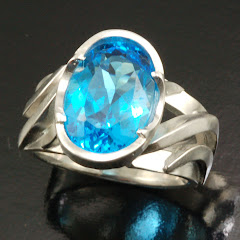Above: Opal doublet in gold by Jim Charneski
We love the range of color in Australian opal for our Asheville jewelry. Its a very special stone that can display any color in the spectrum. We appreciate all the varieties, and carefully choose the setting to compliment the individual stone. The quality of stone will determine the type of metal we use; lower grade opal for silver, and the good stuff for gold settings.
Opal Supply
Opal is found in many places, including the United States, but 90% of the supply comes from Australia. Opal is found in small supply in a few different states of the US; Idaho, Arizona, and Nevada. Mexico produces a type of transparent opal often referred to as “fire” opal that is a different class of opaque stone without the play of color you see in Australian opal. We prefer Australian opal for the depth and unique look.
Types of opal in jewelry
2% of the supply of Australian opal is boulder opal, making it the most prized and expensive. Any opal that is a solid piece of opal is boulder, and it's almost always used in fine gold or platinum jewelry. Most of the opal you see in most fine jewelry are opal doublets, thin sheets of opal that have been overlayed on top of potch opal or another material and glued together. This achieves that bright iridescence you commonly see in opal jewelry, with less material. This type of opal has a much lower cost then boulder. Opal doublets really capture attention and are the best value for the money. The third step down would be a triplet, which is a doublet with another clear material over the top of the piece, such a quartz. This layer helps to protect the stone, but is usually reserved for lesser quality opal.
What to look for
When choosing opal and opal jewelry look for a depth of color. Flashes of red or yellow that seem to dance underneath the surface, giving the stone a layered affect. The best specimens can be light or dark in color, but they will have a depth of color to them that sets them apart from cheaper stones. Better stones have more reds and yellows throughout the stone, and you want to look at the stone from every direction to see how the colors play in the light. Better quality stones will have that iridescence from every viewing angle.






No comments:
Post a Comment